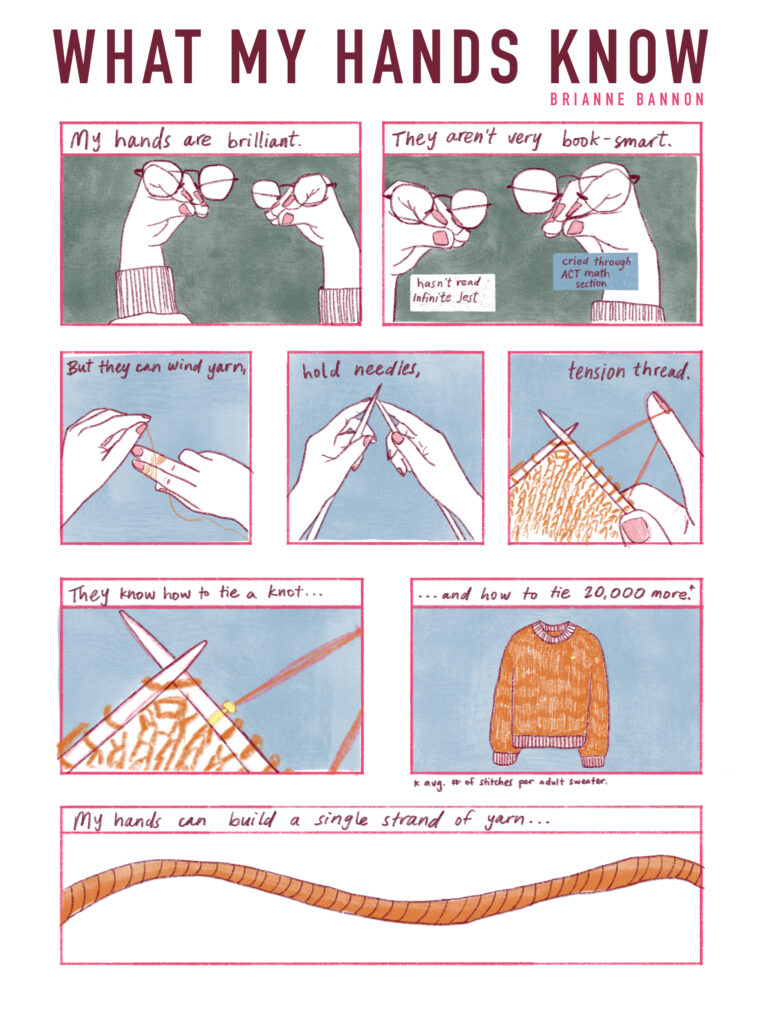
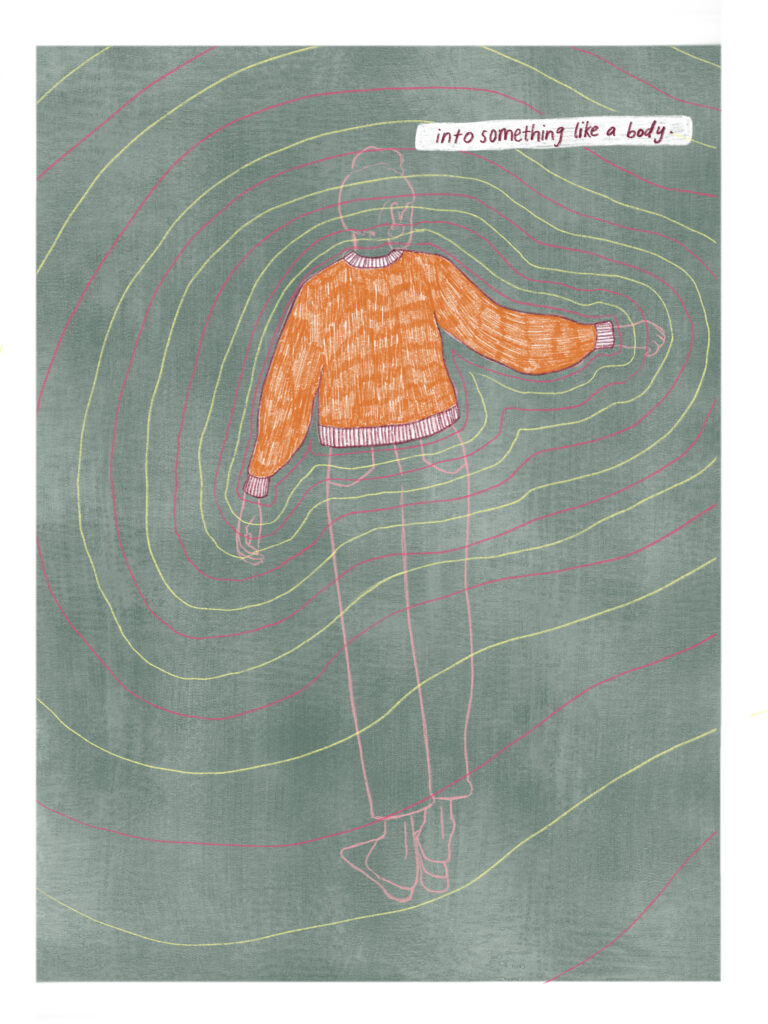
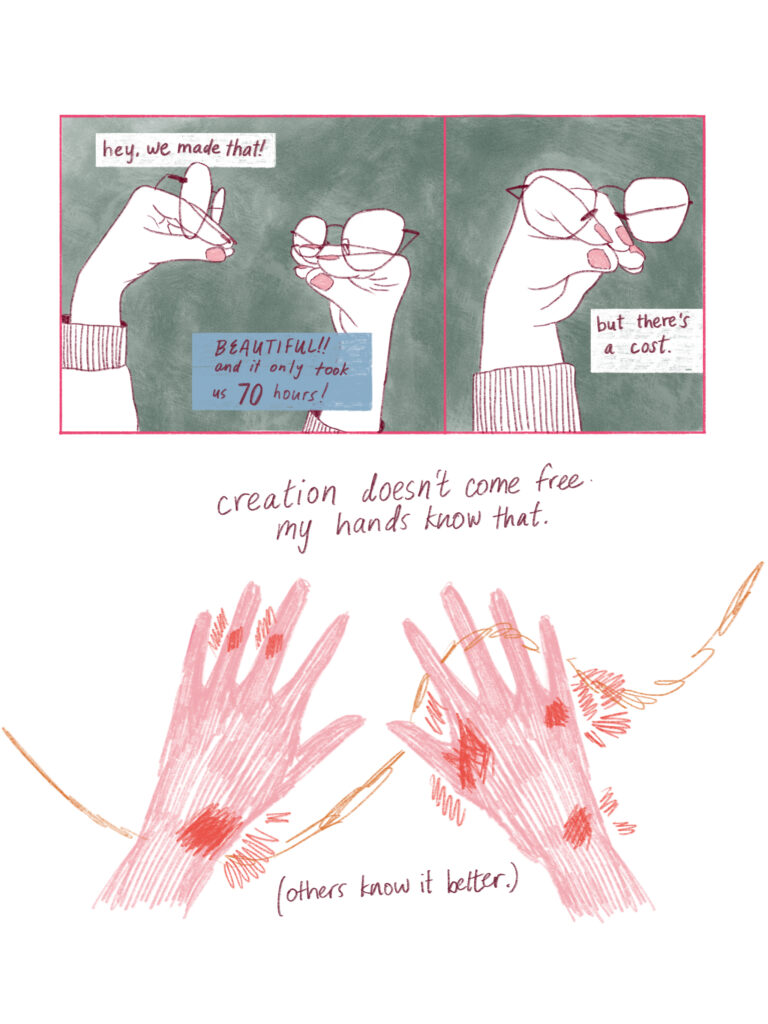
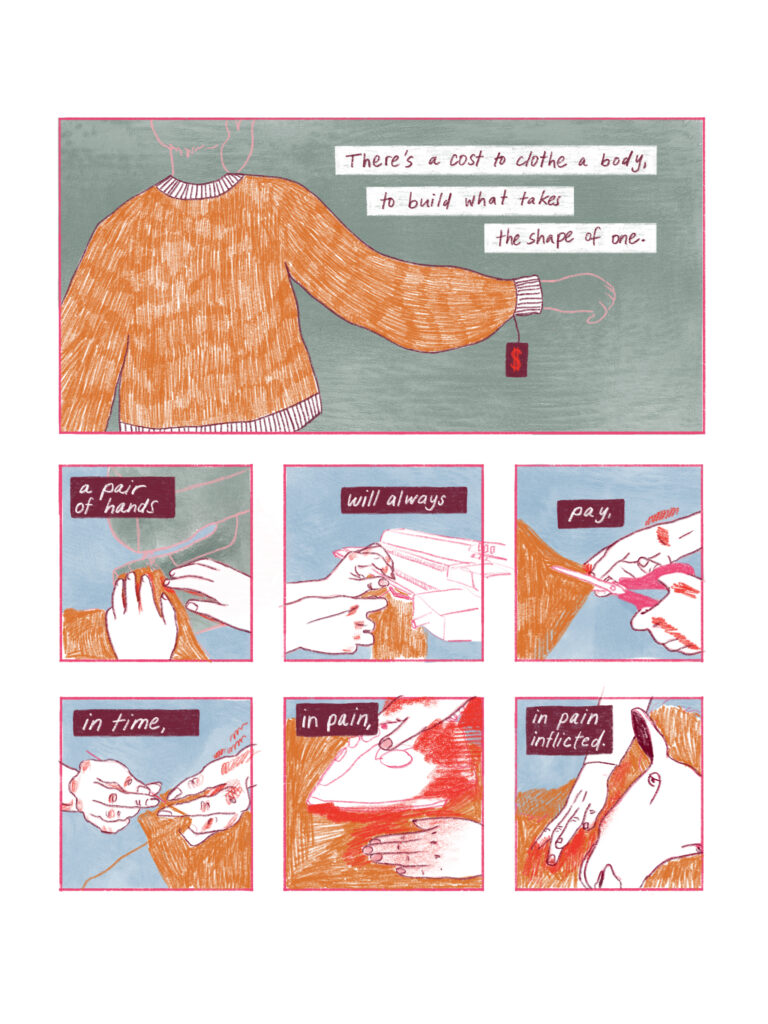
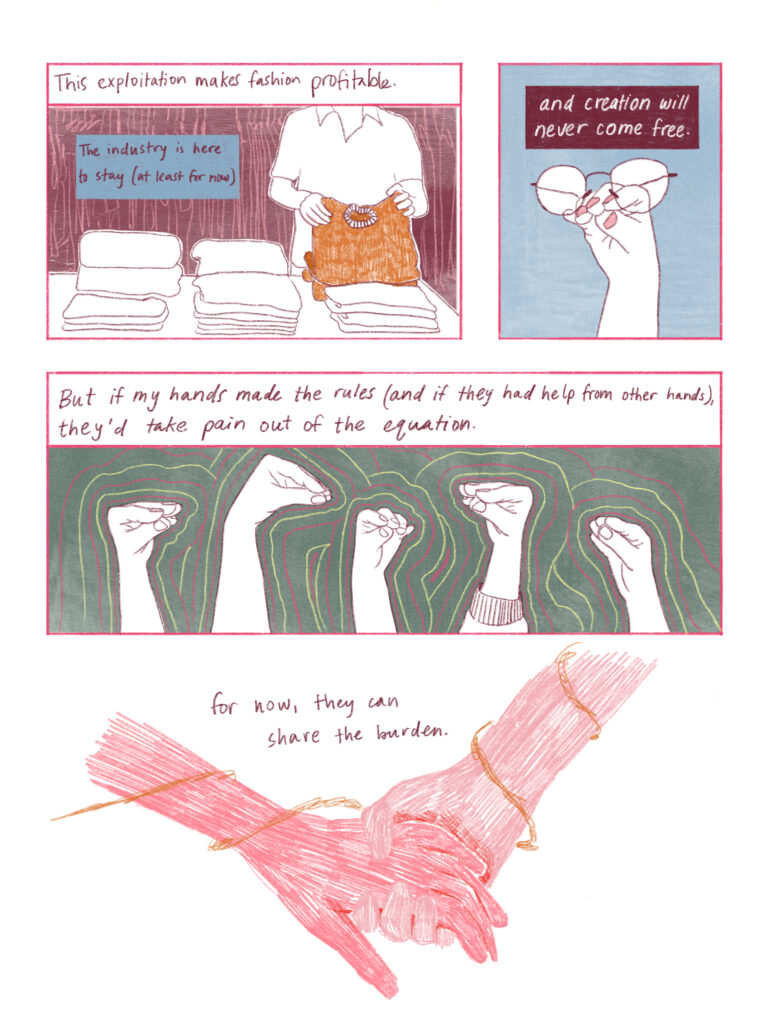








Artist’s statement: This 8-page sequence, “Shards,” is part of a longer graphic memoir (in progress) titled InQuest. The memoir documents my own experience in a psychiatric hospital during a particularly intense mental health crisis, and my slow reentry to life routines after returning home.
I can still feel those experiences in my muscle memory. I vividly recall the sensations of fear, confusion, desperation, and dissociation. I could tell I was not making sense to those around me, but did not know how to change that. I was flooded with perception and realization, but could not find a coherent way to express what was happening in my mind.
One image that has stayed with me ever since this time is that of a sharp squiggly shape, like a shard of glass. When I imagine this shard shape, it represents fragmentation of thought and of self – which is what that experience felt like to me. My thoughts were not missing or meaningless simply because they did not make sense to those around me. My thoughts were there and they had meaning, they were just splintered. It would take time to reassemble them – and myself – after that splintering.
What I hope comes across in this work is the message that all parts of ourselves are valid and meaningful – even the shards and splinters. It may be tempting to dismiss or discard the sharper, more painful pieces of ourselves, seeing them as dangerous by nature. But if we discard these pieces, we are discarding pieces of our full selves. If we deem those shards as “dangerous” by nature, then what are we saying about ourselves?
Instead of dismissing people during their most difficult times, we must strive to accept and support folks for precisely who and how they are in the moment. Mental health is not an end goal. It is fluid and messy and unpredictable. It is not contingent on everything going as expected. Acceptance and support, then, shouldn’t be contingent on that either.
To see the author discussing the work in context with the larger project, click below:
I have 31,639 photos saved on my phone. I am a hoarder of many things: pictures, videos, trinkets, birthday cards, dead flowers, and most significantly, memory.

The Cloud has allotted me a dangerous ability to hold on to and reflect on moments more than one should be able to. My photo album eats up a large chunk of the phone’s storage. I feed it continuously with the promise of deleting, although I rarely do: what would I lose if I were to rid my phone of the thousands of images I likely don’t need? It’s a question I’ve considered but have been afraid to answer.
There are pictures of me in all different stages of adulthood saved to my phone. There are some from my first years of college and some from the last. Ones from graduate school and after. There are pictures of exes, friends, and family. My dog, other people’s dogs, random insects with which I’ve had portrait-mode photoshoots. There are photos of people I’ve loved and people I currently love. There are photos of people who are dead. I hold onto them as though keeping them will stop the years without those people from expanding.
I can look at a photo, just about any that I’ve taken or been in, and know exactly what I was feeling at the time.
See: a picture of me smiling in a bird store, a blue-and-yellow macaw perched on my arm. I see that and I remember how it feels to have been loved in all of the wrong ways. Not pictured: a man who only phones after dark; my face pressed into the carpet of his bedroom floor; a chronic stomach ache; ten months and the more I will let him take from me. The bird is a shining gold and royal blue. I am the smallest version of myself I have ever been. I keep the picture on my phone for days when I need to remember whom I have survived.

I keep the pictures I took in my yellow-lighted bathroom of my stomach flexing in the mirror, daring abs into view. Not pictured: a fear of rice; a fear of bread; a fear of pasta; a fear of carbs; protein bars that made me sick; a near empty refrigerator; the day I ate nothing but broccoli; the urge to cry at every restaurant; crying when the toast came out buttered; heat exhaustion; dehydration; a boyfriend with an Instagram feed full of women who are not me; a boyfriend who does not love me and never will; an image of health that is anything but.
A picture of my best friend from college and me: a selfie we took with soft smiles, another where we are squeezed together in a hug in front of a street sign in somebody’s backyard. Not pictured: the drugs in our system, prescribed and recreational; the many midnight trips to In-N-Out via Uber; laughing so hard one of us pees; me getting cursed out for not sharing someone else’s cocaine; Saturdays at the mall; Sundays at the beach; the years to come and her last; a tweet that sounds like a suicide note; months of therapy; a lifetime of regret.

A picture of my father and I on a trip to California from when I was in high school, both of us smiling, his head bald. Not pictured: the two years of uncertainty; the chemo that was supposed to be radiation; coming back from summer camp to find him without hair; fear of what if and a possible recurrence looming on every horizon.
A picture of an ex and me on vacation in Mexico. I’m wearing a long black dress with embroidered flowers. He is kissing my cheek. Not pictured: a very public elevator fight; the weeklong trip without any sex; our blatant incompatibility.

A picture of a wall with blue-potted flowers that I took on a trip to Spain with my dad. Not pictured: me hyperventilating the entire plane ride, in the hotel room, outside of the hotel room; the realization that nothing is real; the realization that I am not real; an overwhelming sense of impending doom; the desire to throw myself off of the tallest building; panic attacks that feel like death; wanting to be anywhere else but on Earth.

A picture of me at the county fair, smiling between two friends, stuffed unicorn prize and bag of cotton candy in hand. Behind us, the Ferris wheel rotates. Not pictured: the longest summer of my life; the third psychiatric medication in two months, the first making me unbearably dizzy; the fear that this feeling may never end; psychiatrist appointments; doctor’s appointments; therapy appointments; seventeen hours of sleep a day; taking thirty minutes just to pee because this body didn’t feel like it was mine; Xanax to keep me from crawling out of my flesh; Wellbutrin that makes me manic; the fear that I will be this way for the rest of my life; the knowledge that I will be, cyclically.

A picture of a sunset on the beach I took from my apartment window, the sky settling into an amalgam of blue and pink and orange. Not pictured: two nights before this one; a man who does not warn me before he is on top of me; a man who takes and then leaves; his remnants on my face; three showers in a row; cowardice of keeping quiet; memory that will haunt and disrupt.

A picture of me and friends at a sorority formal circa 2015. Not pictured: the excessive drinking beforehand; a shortage of chicken wings and fried macaroni balls at the event; a mediocre DJ; a bus ride full of vomit and no plastic bags in sight.
Thousands of pictures of my dog. Not pictured: constant crying due to the realization that someday my dog will die.

A picture of my hand with a ring on it. Not pictured: my hand shaking with twice the speed it usually does as it is slipped on my finger; his hands also shaking; a love I have always wanted and now have.

My grandparents’ wedding photo. My father in college. A picture I took of a picture of my mother at sixteen. Random farm animals I’ve pet. My birthday cake from four years ago. A meal that changed my life. An incredible croissant I consumed in under 20 seconds. Places I’ve been. Memes that have made me smile. Memes that have made me laugh. Poems that have made me cry, or pause, or have left me with an open mouth. Places I have lived. Things that have made me say, “I need to take a picture of that.” It is both a blessing and a curse to be able to capture, to keep, to review. I hold on to both the bad and the good. I want to remember feeling of any kind. Not pictured: all of the things I wish I had taken more footage of. Not pictured: all of the life that existed before I held a camera phone. Not pictured: the life I have [yet] to experience.

This comic strip is an adaptation of part of the first Lemminkäinen cycle in the Finnish epic, The Kalevala. The Kalevala is an adaptation of the oral folklore of Karelia and Finland written by Elias Lönnrot and is considered a major cornerstone of Finnish identity and culture. I started reading The Kalevala to get a better context for some of the metal music I listened to and found myself drawn to the women in these narratives. To me, they were as interesting (if not more so) than the male heroes. Lemminkäinen’s mother, in particular, is my favorite character, despite not being given a name herself. In this comic, I hoped to capture her own heroic journey and how her son’s happy ending did not necessarily lead to her own.
“Muybridge Comics” challenges the division between comics and visual art. While all comics are necessarily a form of visual art, most comics do not encourage individual images, or panels, to be viewed independently from their sequences. “Muybridge Comics” attempts both approaches, with the final two installments assembling the two, interwoven, four-part sequences into combined images more reminiscent of traditional comics pages. “Muybridge Comics” adapts photographs from the motion studies “Two Women Kissing” and “Two Men Wrestling” published in Eadweard Muybridge’s 1887 Animal Locomotion.
“After Kafka” is a series of one-panel comics. Each picture is a visual interpretation of one of Kafka’s “shorter stories” from Franz Kafka: The Complete Stories. I first encountered Kafka’s work many years ago and found the reality within it to be strange, ridiculous, absurd, even impossible. Returning to Kafka’s work recently, I had a similar experience. Only this time, I had a strong connection with the unreality of it. Perhaps this is because I am older. Or, maybe it has something to do with the fact that I am now sober. Or, quite possibly, it has something to do with the current times. Whatever the reason, engaging with Kafka’s “shorter stories” provided me with pleasure upon pleasure. “After Kafka” is an attempt at honoring Kafka and his irresistible vision.

We admitted we were powerless
this is called visitation.
I made a family of the towers. The one with a heart in her center and the pointed tips of a hat, the mother. In the summer weeks that were his we rode in the car for an hour, backpacks with coloring books and dinosaurs, quarters for vending machines.
We followed the power lines out to the river, past signs for evacuation routes. Gas stations with tanning beds, boiled nuts in greasy bags, bathrooms we weren’t allowed to go in. We pretended to work, typing newsletters on typewriters, wearing headsets not connected to the phone.
I want to be involved in raising the child/ren.
*
We came to believe
Only her mother could talk about him in a natural way
*
Restore us to sanity
A straight line is not the shortest distance between two points
I believe visitation is in the child/ren’s best interest.
*
We made a fearless moral inventory of ourselves
“Just what was your father’s line of business?”
“Some kind of scientist, wasn’t he?”
*
Another human being
“When would you go, if you could time travel?”
“I’d go back and see my parents when they were younger.”

*
We’re entirely ready
I woke up when a man in a black cowboy hat got into the car parked next to ours. The familiar. A slamming door. My sister, asleep in her car seat, a slow drip of apple juice, crushed crackers against her legs. The sign from the building made a pink blur on the back window. Hours later, my mother returned. She smelled like someone else.
I have a safe place for the child/ren to stay during visitation.

*
To remove
My mother asked about my dog. A name of some vague relative.
She would be happier in the countryside, without fences, away from the apartment with two bedrooms and twin beds.
Years later I learned she was bred, litter after litter. When I was sixteen, my mother pointed out the house as we drove by—a fence and a chain, the grass worn away.
*
We made a list
*
To do so would injure them or others
You and the child/ren will know when you can spend time together.
She knew that if her father could not get her through
the wall
he would stay
*
We continued to take
I will support the child/ren as ordered by the court to the best of my ability.
*
To carry that out
The court will send you a letter
“Do you think things always have an explanation?”

*
To carry this message
This is not a fairy tale.
I swear that I am able
to take care of the child/ren
listed above.
I am
a fit and proper
person.

Works Cited
Alcoholics Anonymous: Big Book. 4th Edition. A.A. Grapevine, Inc. 2001. Print.
“Figure 1. Single circuit (a) and double circuit (b) transmission line towers for 154kV.” ResearchGate.www.researchgate.net/figure/269101284_fig1_Figure-1-
Single-circuit-a-and-double-circuit-b-transmission-line-towers-for-154-kV
“Form PS-06: How to Ask for a Visitation.” Rev. 8/08. Alabama Administrative Office of Courts. eforms.alacourt.gov/Do%20It%20Yourself%20Forms/ Petition%20for%20Visitation.pdf
L’Engle, Madeline. A Wrinkle in Time. New York : Square Fish, 2007. Print.
NOAA. “Public Severe Weather Outlook.” NWS Storm Prediction Center. Norman, OK.
0423 AM CDT Wed Apr 27 2011. www.spc.noaa.gov/products/outlook/ archive/2011/pwo_201104271035.html
NOAA. “Particularly Dangerous Situation (PDS): Tornado Watch 235.” NWS Storm Prediction Center. Norman, OK. 145 PM CDT Apr 27 2011. www.spc.noaa.gov/products/watch/2011/ww0235.html
Hartley, P. “HVDC Transmission: Part of the Energy Solution?,” James A. Baker III Institute for Public Policy, Rice University, May 2003.
Siemens. “Typical Transmission Line Structures for approx.. 2000 MW.” www.energy.siemens.com/br/pool/hq/power- transmission/HVDC/applications-benefits/benefits-hvdc-4-b_463.jpg